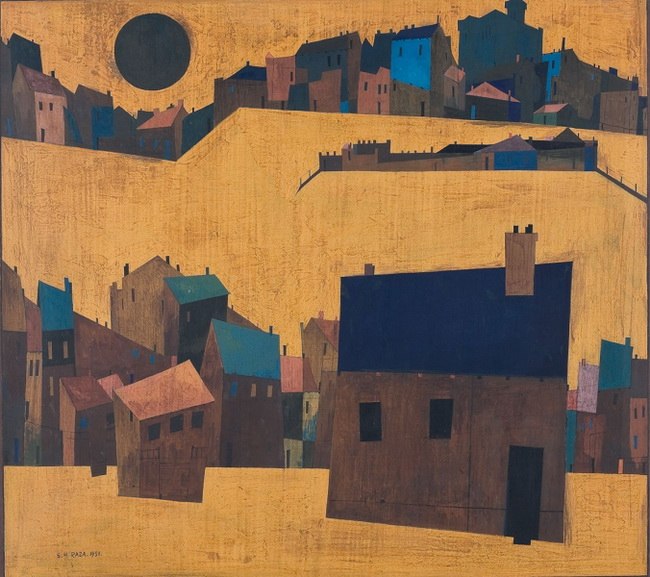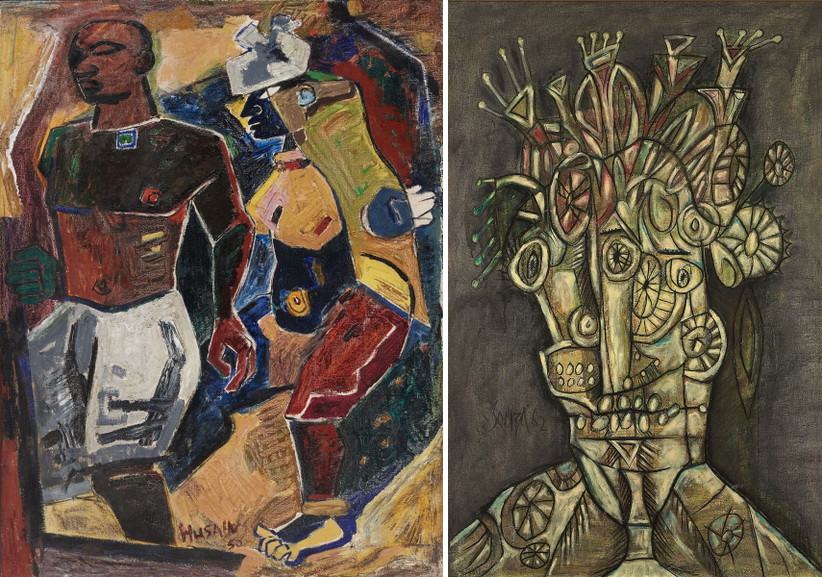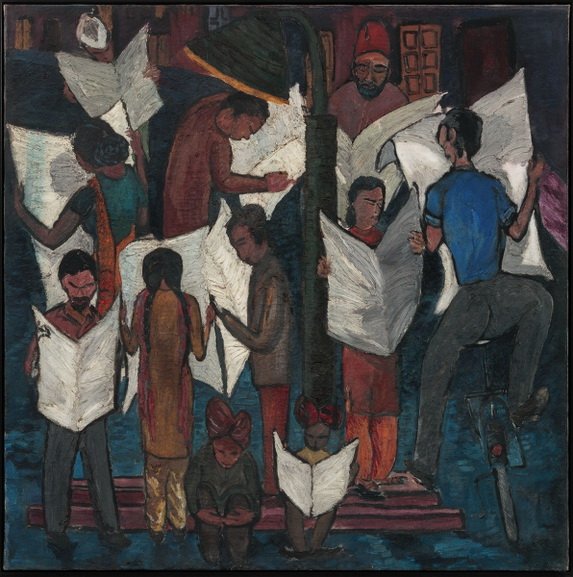The Progressive Revolution Modern Art for a New India
The history of India is in part linked to the British colonial rule, which lasted for more than than three centuries. Throughout that time, the artistic production had its particular form, yet it was not entirely free from the constraints of tradition. That largely inverse in 1947 after the proclamation of India's declaration of independence; a time when a new generation of art makers united to create the Progressive Artists' Group.
Currently on brandish at Asia Society Museum in New York is an exhibition called The Progressive Revolution: Modern Art for a New India, set to explore and present the ideological standpoints of the Group also as their piece of work in a broader social, cultural, and religious context.
The show features a number of revolutionary works produced between the 1940s until 1990s by artists such as K. H. Ara, S. Chiliad. Bakre, H. A. Gade, M. F. Husain, S. H. Raza, and F. North. Souza, along with later members and figures closely affiliated with the movement such as V. Southward. Gaitonde, Krishen Khanna, Ram Kumar, Tyeb Mehta, Akbar Padamsee, and Mohan Samant.

The Formation of the Bombay Progressive Artists Group
Information technology was F. N. Souza, S. H. Raza, M. F. Husain, K. H. Ara, H. A. Gade, and S. Yard. Bakre (the just sculptor in the grouping) who formed The Progressive Artists' Grouping. Their main agenda was to put an end with the revivalist nationalism established past the Bengal schoolhouse of art, although they adopted i of their strategies which was the recovery of older, pre-colonial art forms. The germination happened a couple of months prior to the official partition of Republic of india and Pakistan. While India chose the path of secularism proposed past its starting time Prime Government minister, Jawaharlal Nehru, Pakistan pursued a Muslim identity.
The founding fathers of the group used to underline that the partition caused a fire in them and and then they wanted to embrace new ideas and comprise them in art; the artists profoundly believed in the emancipatory power of art, secularism, unity, and internationalism.
The Group embraced European Modernism, and the members worked in different styles; by combining the personal and political, historical narratives and abstruse principles, every bit well as the heritage of Indian aesthetics, they started producing highly innovative and aesthetically bold works regardless of the cannons of content and technique. They followed respectable laws of plasticity, aesthetic order, color, and limerick.
Here, it is important to underline that all of the members of PAG came from dissimilar parts of the vast land and belonged to dissimilar form and caste - they were Hindus, Muslims, and Christians, which made them practically the propagators of the Nehruvian platonic of secularism.
Vasudeo S. Gaitonde, Krishen Khanna, Prafulla Dahanukar and Mohan Samant joined the Grouping in 1950. Sadly, after Souza and Raza went in exile, Southward.K. Bakre also left, and the group ultimately disbanded in 1954.

The Installment
The exhibition is curated by Dr. Zehra Jumabhoy, Associate Lecturer, The Courtauld Found of Art, London, and the Manager of Asia Social club Museum Boon Hui Tan. The works are complemented by pre-modern Asian objects from the drove of Blanchette and John D. Rockefeller, which formed the cadre of the Asia Social club's holdings. The objects such as a Pahari miniature, a Chola bronze, and a Japanese curlicue, underline the connections with other cultures and provide a much complex reading of Indian art that is often exoticized.
Dazzled by their new and socially engaged paradigm, during the 1950s the artists depicted everyday life in guild to critically articulate the sociopolitical landscape and its economic hardships. This exhibition offers an assortment of works, but perhaps the two examples sum upwards their artistic visions best.
The outset i to mention was made by Krishen Khanna in 1948 and is called News of Gandhiji'southward Death. It reflects a highly tragic upshot – the 1948 assassination of Mahatma Gandhi, the spiritual father of the nation, by a Hindu right-fly zealot. The composition depicts Hindus, Muslims, Sikhs, and Christians gathering nether a street light reading the tragic news.
The second piece of work on display is an oil painting produced past an artist Akbar Padamsee in 1952 titled Lovers. Information technology is an eroticized and colorful delineation of a stylized man and woman seated atop a white bull. Although the painting was a modernized accept on the divine couple Lord Shiva and Goddess Parvati, the local government saw the work as immoral and offensive due to scenes of sex.

The Indian Progressive Revolution at Asia Society
This exhibition is of import since information technology is the first one representing Indian modernists on American soil. Furthermore, information technology reflects how this post-colonial society struggled to obtain the revolutionary ideals past sorting out the trauma of Division and the question of national identity from the perspective of Progressive Artists Grouping, one of the most important art movements in India until today. Finally, the show offers a rare and valuable chance to see historically meaning works of mod Indian masters together.
The Progressive Revolution: Mod Art for a New India will exist on display at Asia Society Museum in New York until twenty January 2019.

Editors' Tip: The Progressive Revolution: Mod Fine art for a New India
Formed just months after the 1947 Partition of India and during tremendous violence and protest, the Progressive Artists Group (PAG) included artists seeking a break with their country's past and its cultural constraints. For near a decade these painters and sculptors explored ideas about art for a new nation. Through lush illustrations and scholarly essays, this volume looks at the brand of modernism the grouping consort and its relevance and importance to contemporary art. The careers of artists K.H. Ara, S.Chiliad. Bakre, H.A. Gade, V.Due south. Gaitonde, M.F. Husain, Krishen Khanna, Ram Kumar, Tyeb Mehta, Akbar Padamsee, S.H. Raza, Mohan Samant, and F.N. Souza are presented in three sections.
Featured paradigm: One thousand. F. Husain - Yatra, 1955. Oil on canvas. H. 33 ane/ii x W. 42 ane/2 in. (85.1 ten 108 cm). Drove Kiran Nadar Museum of Art, New Delhi. All images courtesy Asia Society Museum.
Source: https://www.widewalls.ch/magazine/bombay-progressive-artists-india-modern-art
0 Response to "The Progressive Revolution Modern Art for a New India"
Postar um comentário